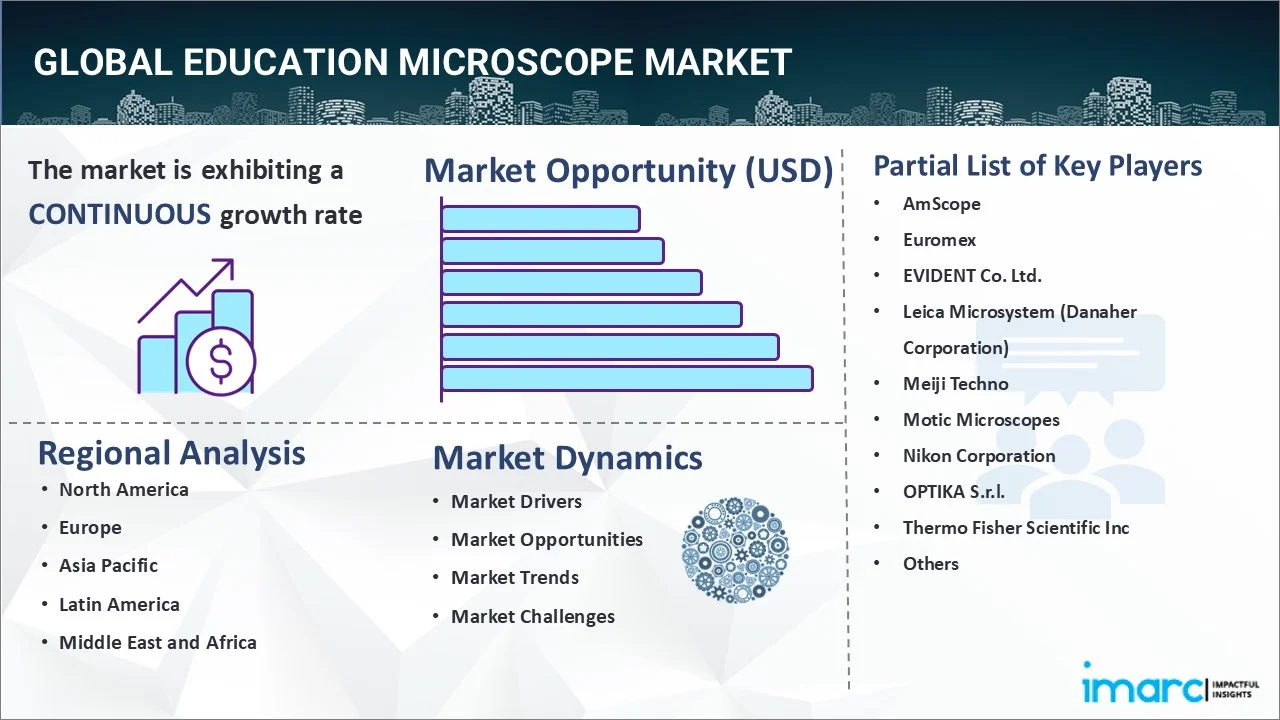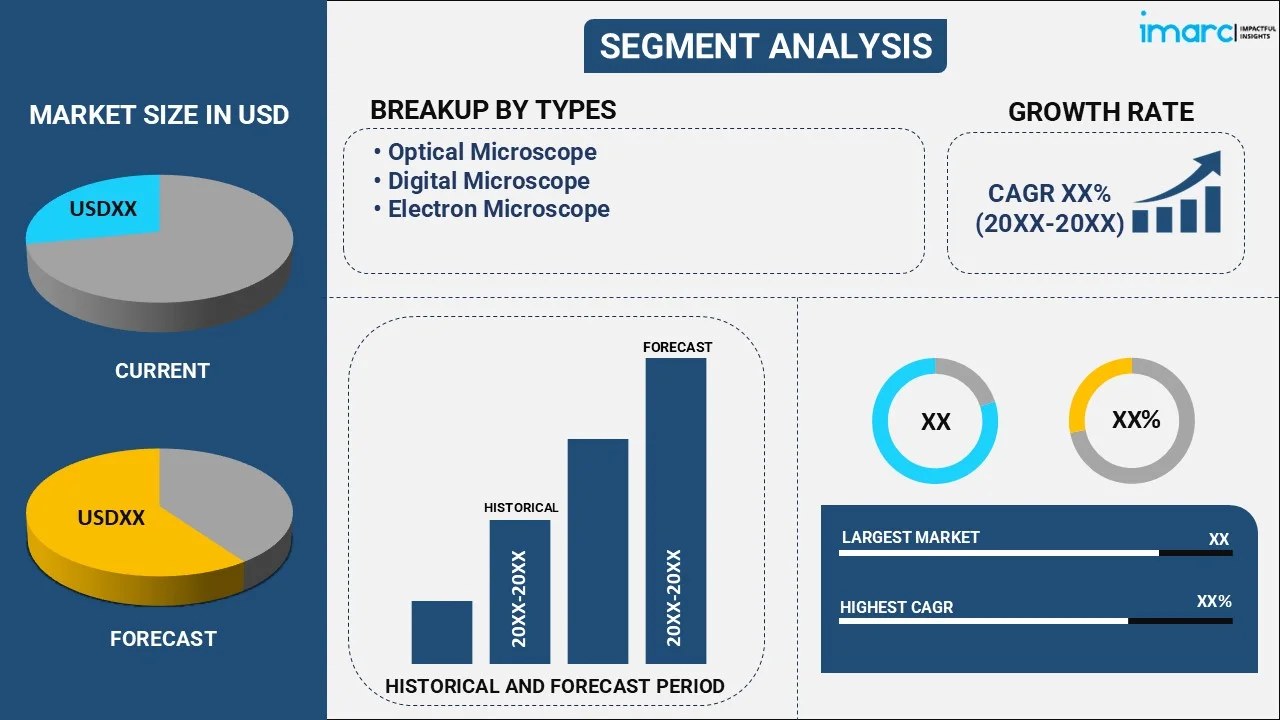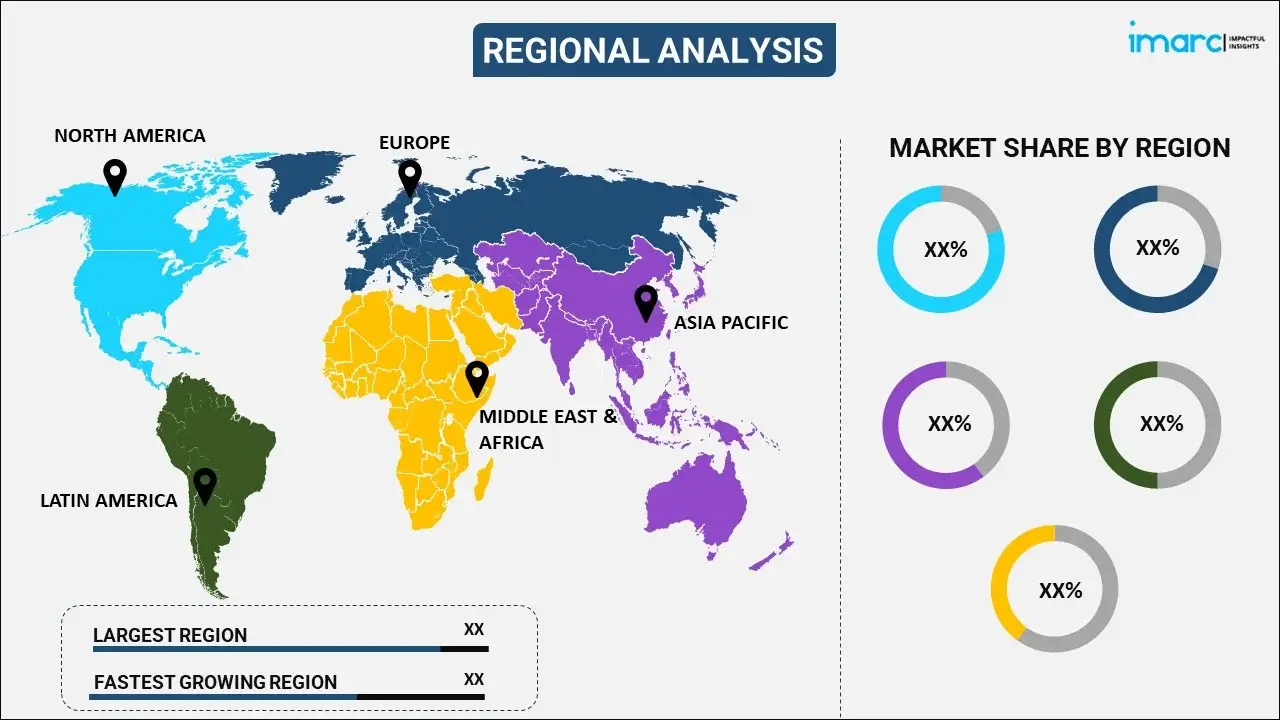
Education Microscope Market Report by Type (Optical Microscope, Digital Microscope, Electron Microscope), Application (Laboratory, School, and Others), and Region 2025-2033
Education Microscope Market Overview:
The global education microscope market size reached USD 411.11 Million in 2024. Looking forward, IMARC Group expects the market to reach USD 617.0 Million by 2033, exhibiting a growth rate (CAGR) of 4.61% during 2025-2033. The market is witnessing significant growth, driven by the increasing emphasis on practical learning and STEM education in schools and colleges, technological advancements in microscope manufacturing, and rising awareness about the benefits of hands-on scientific exploration.
|
Report Attribute
|
Key Statistics |
|---|---|
|
Base Year
|
2024 |
|
Forecast Years
|
2025-2033
|
|
Historical Years
|
2019-2024
|
| Market Size in 2024 | USD 411.11 Million |
| Market Forecast in 2033 | USD 617.0 Million |
| Market Growth Rate (2025-2033) | 4.61% |
Education Microscope Market Analysis:
- Market Growth and Size: The market is witnessing moderate growth on account of the increasing investment in educational infrastructure, along with the rising focus on science, technology, engineering, and mathematics (STEM) education.
- Technological Advancements: The integration of digital imaging and analysis capabilities benefits in enhancing teaching and learning experiences.
- Industry Applications: Education microscopes find applications across various educational levels, including primary, secondary, and higher education institutions, and in research laboratories.
- Geographical Trends: North America leads the market, driven by the presence of well-established educational systems. However, Asia Pacific is emerging as a fast-growing market due to favorable government initiatives.
- Competitive Landscape: Companies are focusing on product innovation, strategic partnerships, and expanding their presence in emerging markets to gain a competitive edge.
- Challenges and Opportunities: While the market faces challenges, such as the high cost of advanced microscope systems, it also encounters opportunities on account of the increasing adoption of online learning platforms.
- Future Outlook: The education microscope market outlook looks promising, with the rising focus on digitalization in the education industry. Besides this, the escalating demand for customizable and personalized microscopy solutions is anticipated to bolster the education microscope market growth.

Education Microscope Market Trends/Drivers:
Increasing demand for quality education
The global education microscope market is significantly influenced by the escalating demand for quality education worldwide. As populations grow and economies develop, there is a heightened awareness of the pivotal role education plays in personal and societal advancement. As students and educators seek more immersive and effective learning experiences, the adoption of advanced tools like microscopes becomes essential. These devices enable students to explore the intricacies of various subjects, promoting a deeper understanding of scientific concepts. Additionally, the rising emphasis on research-oriented and practical learning approaches further drives the education microscope market demand in schools, colleges, and universities.
Advancements in technology
The education sector has witnessed a remarkable transformation with the advent of technological innovations. Advancements in e-learning platforms, virtual classrooms, and digital content delivery have revolutionized the way education is imparted and received. These technological developments have had a profound impact on the education microscope market. Modern microscopes are equipped with digital interfaces, allowing seamless integration with digital learning environments and enhancing their learning experience. Furthermore, the incorporation of augmented reality (AR) and virtual reality (VR) technologies into microscopes offers a new dimension of interactive learning, which is stimulating the market growth.
Government initiatives and policies
Governments around the world have recognized the pivotal role of education in driving economic growth and societal progress. As a result, they are formulating various initiatives and policies to enhance the quality and accessibility of education. Investments in educational infrastructure, teacher training, and technology integration have been key areas of focus. Many governments offer financial support to educational institutions to procure modern educational equipment, including microscopes. These initiatives aim to bridge the educational divide and provide students with the necessary resources for a well-rounded learning experience. Additionally, public-private partnerships in the education sector have gained momentum, facilitating the adoption of advanced technologies like microscopes in schools and colleges. The support of governments in promoting education has created a conducive environment for the growth of the global education microscope market.
Education Microscope Industry Segmentation:
IMARC Group provides an analysis of the key trends in each segment of the global education microscope market report, along with forecast at the global, regional, and country levels for 2025-2033. Our report has categorized the market based on type and application.
Breakup by Type:

- Optical Microscope
- Digital Microscope
- Electron Microscope
Optical microscope dominates the market
The report has provided a detailed breakup and analysis of the market based on the type. This includes optical microscope, digital microscope, and electron microscope. According to the report, optical microscope represented the largest segment.
Optical microscopes dominate the market due to their long-standing presence and wide applicability in various educational settings. These microscopes utilize visible light to magnify and observe specimens, making them affordable, user-friendly, and accessible to educational institutions of all levels. The increasing demand for quality education and practical learning experiences drives the adoption of optical microscopes in schools and universities. Moreover, technological advancements in optics have led to improved imaging capabilities, enhancing the educational value of these microscopes. Their versatility in examining a wide range of samples, from biological to geological, further solidifies their position as the preferred choice in educational settings.
Breakup by Application:
- Laboratory
- School
- Others
The report has provided a detailed breakup and analysis of the market based on the application. This includes laboratory, school, and others.
The education microscope market in the laboratory segment is driven by the necessity of high-quality microscopes in scientific research and experimentation. Their importance in the observation and analysis of microscopic specimens, and the increased research activities in life sciences, biotechnology, and healthcare industries, have led to a consistent demand. Further, the need for precision in material science and forensics reinforces the adoption of specialized microscopes. The school segment is vital due to the emphasis on practical learning in curricula and government initiatives to enhance science education, resulting in greater accessibility of microscopes. The 'others' segment comprises diverse applications outside of schools and laboratories. This includes non-traditional educational venues, homeschooling, and online education, as well as industry-specific uses in agriculture, environmental sciences, and art restoration. Thus, each segment contributes uniquely to the overall growth of the education microscope market.
Breakup by Region:

- North America
- United States
- Canada
- Europe
- Germany
- France
- United Kingdom
- Italy
- Spain
- Others
- Asia Pacific
- China
- Japan
- India
- South Korea
- Australia
- Indonesia
- Others
- Latin America
- Brazil
- Mexico
- Others
- Middle East and Africa
North America exhibits a clear dominance, accounting for the largest education microscope market share
The report has also provided a comprehensive analysis of all the major regional markets, which include North America (the United States and Canada); Europe (Germany, France, the United Kingdom, Italy, Spain, and others); Asia Pacific (China, Japan, India, South Korea, Australia, Indonesia, and others); Latin America (Brazil, Mexico, and others); and the Middle East and Africa.
North America dominates the education microscope market due to the region's strong focus on advanced scientific research and STEM education, especially in academic institutions. Additionally, the presence of renowned microscope manufacturers and innovative technology companies drives product development and accessibility. Furthermore, government initiatives promoting science education contribute to the market growth. The region's high investment in healthcare and life sciences also leads to a significant demand for research-grade microscopes. Moreover, collaborations between educational institutions and industry players facilitate technology transfer and knowledge dissemination, fostering the market's expansion.
Competitive Landscape:
The competitive landscape of the education microscope market is characterized by a diverse array of players striving to establish their foothold in this rapidly growing industry. Key participants include established manufacturers with a strong global presence, specialized companies focusing solely on educational equipment, and emerging startups offering innovative solutions. Leading companies in the market leverage their brand reputation and extensive distribution networks to capture significant market share. They invest in research and development (R&D) to introduce technologically advanced microscopes, meeting the evolving demands of educational institutions and researchers.
Specialized companies catering exclusively to the education sector carve out niche markets with their tailored offerings, providing comprehensive solutions for various educational levels and subjects. These players often emphasize user-friendly interfaces and cost-effectiveness to attract educational institutions and budget-conscious buyers and increase education microscope market revenue. Additionally, startups and smaller players contribute to the competitive landscape by introducing disruptive technologies and creative business models, challenging established norms and driving innovation in the industry.
To maintain a competitive edge, companies focus on continuous product improvement, strategic partnerships with educational institutions, and efficient after-sales support. The dynamic nature of the education microscope market fosters healthy competition, benefiting customers with a wide range of choices and driving overall market growth.
The report has provided a comprehensive analysis of the competitive landscape in the market. Detailed profiles of all major companies have also been provided. Some of the key players in the market include:
- AmScope
- Euromex
- EVIDENT Co. Ltd.
- Leica Microsystem (Danaher Corporation)
- Meiji Techno
- Motic Microscopes
- Nikon Corporation
- OPTIKA S.r.l.
- Thermo Fisher Scientific Inc
- ZEISS Group
Education Microscope Market Report Scope:
| Report Features | Details |
|---|---|
| Base Year of the Analysis | 2024 |
| Historical Period | 2019-2024 |
| Forecast Period | 2025-2033 |
| Units | Million USD |
| Scope of the Report | Exploration of Historical and Forecast Trends, Industry Catalysts and Challenges, Segment-Wise Historical and Predictive Market Assessment:
|
| Types Covered | Optical Microscope, Digital Microscope, Electron Microscope |
| Applications Covered | Laboratory, School, Others |
| Regions Covered | Asia Pacific, Europe, North America, Latin America, Middle East and Africa |
| Countries Covered | United States, Canada, Germany, France, United Kingdom, Italy, Spain, China, Japan, India, South Korea, Australia, Indonesia, Brazil, Mexico |
| Companies Covered | AmScope, Euromex, EVIDENT Co. Ltd., Leica Microsystem (Danaher Corporation), Meiji Techno, Motic Microscopes, Nikon Corporation, OPTIKA S.r.l., Thermo Fisher Scientific Inc, ZEISS Group, etc. |
| Customization Scope | 10% Free Customization |
| Post-Sale Analyst Support | 10-12 Weeks |
| Delivery Format | PDF and Excel through Email (We can also provide the editable version of the report in PPT/Word format on special request) |
Key Questions Answered in This Report:
- How has the global education microscope market performed so far, and how will it perform in the coming years?
- What are the drivers, restraints, and opportunities in the global education microscope market?
- What is the impact of each driver, restraint, and opportunity on the global education microscope market?
- What are the key regional markets?
- Which countries represent the most attractive education microscope market?
- What is the breakup of the market based on the type?
- Which is the most attractive type in the education microscope market?
- What is the breakup of the market based on the application?
- Which is the most attractive application in the education microscope market?
- What is the competitive structure of the global education microscope market?
- Who are the key players/companies in the global education microscope market?
Key Benefits for Stakeholders:
- IMARC’s report offers a comprehensive quantitative analysis of various market segments, historical and current market trends, market forecasts, and dynamics of the education microscope market from 2019-2033.
- The research study provides the latest information on the market drivers, challenges, and opportunities in the global education microscope market.
- The study maps the leading, as well as the fastest-growing, regional markets. It further enables stakeholders to identify the key country-level markets within each region.
- Porter's five forces analysis assist stakeholders in assessing the impact of new entrants, competitive rivalry, supplier power, buyer power, and the threat of substitution. It helps stakeholders to analyze the level of competition within the education microscope industry and its attractiveness.
- Competitive landscape allows stakeholders to understand their competitive environment and provides an insight into the current positions of key players in the market.
Need more help?
- Speak to our experienced analysts for insights on the current market scenarios.
- Include additional segments and countries to customize the report as per your requirement.
- Gain an unparalleled competitive advantage in your domain by understanding how to utilize the report and positively impacting your operations and revenue.
- For further assistance, please connect with our analysts.
 Inquire Before Buying
Inquire Before Buying
 Speak to an Analyst
Speak to an Analyst
 Request Brochure
Request Brochure
 Request Customization
Request Customization




.webp)




.webp)












